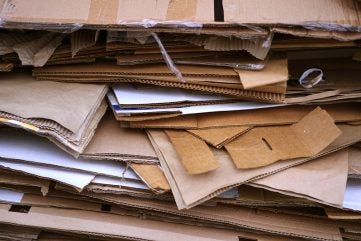
Have you ever wondered what happens to the cardboard you toss into the recycling bin?
Cardboard recycling is a comprehensive six-step process, ensuring the sustainable use of this everyday material. Here’s a quick guide to the process:
1. Collection
The journey begins with the collection of waste corrugated material from kerbside bins or businesses. Whether from consumer bins or industrial agreements, the material is measured and transported to recycling facilities, often housed within paper mills.
2. Sorting
Efficient sorting is crucial. Cardboard coated or waxed for food contact undergoes a specialised recycling process. The remaining material is separated into corrugated cardboard and “boxboard,” thinner material used for items like cereal boxes.
This meticulous sorting sets the stage for diverse grades of material produced by paper mills/recyclers.
3. Shredding and pulping
Following sorting, the material is shredded into fine pieces and then pulped. This involves mixing cardboard with water and chemicals, breaking down the paper fibres into a slurry-type substance.
The pulp is then blended with new or virgin pulp from wood chips, regulating the strength of the new material.
4. Filtering
The pulp undergoes filtration, eliminating foreign objects like tape and glue. A centrifuge process removes contaminants such as plastics and metal staples.
The next step involves removing inks using chemicals, ensuring a clean pulp ready for the final processing stage. The purified pulp can be stored for future use.
5. Finishing
The cleaned pulp is spread out to dry on conveyors and heated cylindrical surfaces, forming long rolls of solid sheets.
Excess water is pressed out during this stage, and additional layers can be added, depending on thickness requirements. This process yields large reels of brown paper, ready to be cut as needed.
6. Creating corrugated boards
The sheets of paper produced can serve as outer liners or fluting for corrugated material. Paper mills can directly sell the material to packaging manufacturers or convert it into various materials before distribution.
Environmental benefits
Recycling cardboard offers a myriad of environmental benefits:
- Energy savings: Using recycled cardboard can result in overall energy savings of 25-50% compared to virgin material.
- Reduced virgin material use: Recycled cardboard utilises 70-100% less virgin material, contributing to resource conservation.
- Water consumption: Recycling cardboard reduces water consumption by up to 99%.
- Emission reductions: Manufacturing recycled cardboard within the UK minimises emissions by avoiding overseas material imports.
Virgin vs. recycled fibres
Understanding the distinction between virgin and recycled fibres is crucial:
- Virgin fibres: Obtained through a chemical process from wood, virgin fibres involve making paper directly from wood. While forests are renewable sources, they require more process water treatment.
- Recycled fibres: Derived from recycled material like cardboard packaging, recycled fibres contribute to sustainability. However, their processing involves more fossil energy.
The environmental impact of each depends on factors such as deforestation and energy consumption during processing. Recycled fibres can be reused about 20 times before becoming too weak.
Recyclable packaging limitations
While recyclable packaging, like corrugated cardboard, is commendable, it’s crucial to consider scenarios where alternatives may be more sustainable:
- Closed-loop supply chains: Reusable plastic totes may outperform single-trip cardboard alternatives, reducing material use, transit costs, and energy consumption.
- Valuable or fragile items: Recyclable corrugated alone might not be suitable for exceptionally valuable or fragile items due to potential damage during transit.
Understanding these limitations ensures a balanced approach to packaging choices, considering both environmental impact and business efficiency.
The business advantages of recycled packaging
While not suitable for every application, recyclable packaging, especially cardboard, presents several advantages for businesses:
- Environmental benefits: Reducing your organisation’s carbon footprint enhances consumer perception of your brand.
- Market positioning: Using easily recyclable packaging allows businesses to position their brand in specific markets, potentially increasing sales among particular demographics.
- Customer satisfaction: Customers who can easily recycle packaging often report higher satisfaction levels, contributing to brand loyalty.
Understanding how cardboard is recycled
Whether you’re curious about the cardboard recycling process or your business extensively uses corrugated packaging, understanding this journey from bin to board is both enlightening and beneficial.
GlobalData analysis finds that a third of businesses expect to see an increase in demand for cardboard packaging in the coming years.
Recycling cardboard not only contributes to sustainability but also brings about positive environmental and business outcomes.



